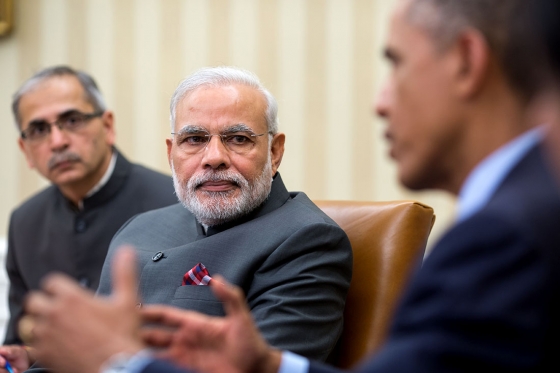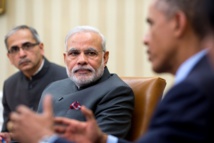However, it is likely that the negative attitude should ease after the agreement on TTP signed this week. In the course of the project, countries that have signed the agreement will encounter many difficulties. Nevertheless, the very fact of signing such an agreement has already shown the power of geo-economics.
There is yet another side to the issue. Washington is not the only country that stands for a strategic reorganization in Asia to respond to the Chinese rise. It is also reasonable to talk about Asia swinging round to the US.
As for Europe, China and the United States are in the center of its attention. In the Europeans’ eyes, China is a threat meanwhile the United States - an ally. And, of course, the two things are closely linked to each other.
The Indian Prime Minister Narendra Modi has been very active on the international scene. From the moment he came to power in May 2014, he visited more than 20 countries, which could be a potential source of foreign capital. The old relations have received new impetus, new ones began to develop.
Modi has a lot of ambition. Recently, XXI century has increasingly been called the Pacific century. However, it seems that the Indian prime minister wants to slightly change the name and rename the XXI century in the Indo-Pacific.
International policy of India is based on two key principles. First is an inevitable link between economic development and geopolitical weight.
Politicians proudly point out that at present, India's economic growth is outstripping the growth of China, which has recently started to decline.
In addition, while China's population is aging, the demographic situation in India progressively involves the energy and activity of youngsters.
Fair enough, yet the fact remains that the Indian economy is not as strong and large as Chinese. In order to catch up with its main rival, India need a decent infrastructure, foreign investment, the latest technologies, and even more.
No surprising here, that each of Modi’s foreign trips has economic implications.
While the head of China Xi Jinping was at a reception at the White House, Modi visited California trying to sell "Indian Dream" to the Silicon Valley giants.
Indian Prime Minister and his Japanese counterpart Shinzo Abe share the view that their countries can work and develop business together.
The second component of Indian politics - the neighborhood. In the past, the Indian leaders had a quite categorically attitude to the smaller neighboring countries, which led to conflicts with Pakistan, Nepal, Sri Lanka, Bangladesh, Bhutan and other countries that were of interest to India.
However, Modi has changed this situation. The conflict with Pakistan over Kashmir will always cause some tension, but the Prime Minister is well aware that major powers seek to mitigate any unrest in neighboring countries.
However, the official rhetoric tends to gloss over India's concerns about China's regional ambitions. Beijing has been painstakingly coaxing India’s neighbors.
The strategy of "one zone - one way", announced by Xi Jinping, aims to turn China into an exclusive Eurasian power.
India also feels that the revival of the Silk Road and the emergence of China in the Indian Ocean is actually a ring of blockade, organized by the power with which India had once fought over territories, still controversial.
Modi needs to balance the concerns of economic engagement. China is an inexhaustible source of investment and technology in the area of infrastructure development.
However, Beijing's ambitions are also good grounds for strengthening relations with India, Japan and Australia, as well as for building new relations with Vietnam, the Philippines and Indonesia. Precisely these relations will develop in contrast to Beijing's ambitions.
Modi’s turn towards Washington is part of the same strategy. India has always been ambivalent about the United States.
Partly, it is still committed to the "strategic autonomy". Internal pride says that India can never be a junior partner in the US-led system. Historically close relations with Russia, which survived the collapse of communism, also play a role.
However, the country needs significant investment and equipment that may be offered only by the most advanced democracy in the world.
Besides, the US is a force that is able to tame China.
The first Prime Minister of India Jawaharlal Nehru once said that foreign policy is a consequence of economic policy. He was right - Modi's dream of the Indo-Pacific millennium depends on economic modernization. Now India is changing, becoming a nation that is able to outbalance the power in Asia.
based on the Times of India's materials
There is yet another side to the issue. Washington is not the only country that stands for a strategic reorganization in Asia to respond to the Chinese rise. It is also reasonable to talk about Asia swinging round to the US.
As for Europe, China and the United States are in the center of its attention. In the Europeans’ eyes, China is a threat meanwhile the United States - an ally. And, of course, the two things are closely linked to each other.
The Indian Prime Minister Narendra Modi has been very active on the international scene. From the moment he came to power in May 2014, he visited more than 20 countries, which could be a potential source of foreign capital. The old relations have received new impetus, new ones began to develop.
Modi has a lot of ambition. Recently, XXI century has increasingly been called the Pacific century. However, it seems that the Indian prime minister wants to slightly change the name and rename the XXI century in the Indo-Pacific.
International policy of India is based on two key principles. First is an inevitable link between economic development and geopolitical weight.
Politicians proudly point out that at present, India's economic growth is outstripping the growth of China, which has recently started to decline.
In addition, while China's population is aging, the demographic situation in India progressively involves the energy and activity of youngsters.
Fair enough, yet the fact remains that the Indian economy is not as strong and large as Chinese. In order to catch up with its main rival, India need a decent infrastructure, foreign investment, the latest technologies, and even more.
No surprising here, that each of Modi’s foreign trips has economic implications.
While the head of China Xi Jinping was at a reception at the White House, Modi visited California trying to sell "Indian Dream" to the Silicon Valley giants.
Indian Prime Minister and his Japanese counterpart Shinzo Abe share the view that their countries can work and develop business together.
The second component of Indian politics - the neighborhood. In the past, the Indian leaders had a quite categorically attitude to the smaller neighboring countries, which led to conflicts with Pakistan, Nepal, Sri Lanka, Bangladesh, Bhutan and other countries that were of interest to India.
However, Modi has changed this situation. The conflict with Pakistan over Kashmir will always cause some tension, but the Prime Minister is well aware that major powers seek to mitigate any unrest in neighboring countries.
However, the official rhetoric tends to gloss over India's concerns about China's regional ambitions. Beijing has been painstakingly coaxing India’s neighbors.
The strategy of "one zone - one way", announced by Xi Jinping, aims to turn China into an exclusive Eurasian power.
India also feels that the revival of the Silk Road and the emergence of China in the Indian Ocean is actually a ring of blockade, organized by the power with which India had once fought over territories, still controversial.
Modi needs to balance the concerns of economic engagement. China is an inexhaustible source of investment and technology in the area of infrastructure development.
However, Beijing's ambitions are also good grounds for strengthening relations with India, Japan and Australia, as well as for building new relations with Vietnam, the Philippines and Indonesia. Precisely these relations will develop in contrast to Beijing's ambitions.
Modi’s turn towards Washington is part of the same strategy. India has always been ambivalent about the United States.
Partly, it is still committed to the "strategic autonomy". Internal pride says that India can never be a junior partner in the US-led system. Historically close relations with Russia, which survived the collapse of communism, also play a role.
However, the country needs significant investment and equipment that may be offered only by the most advanced democracy in the world.
Besides, the US is a force that is able to tame China.
The first Prime Minister of India Jawaharlal Nehru once said that foreign policy is a consequence of economic policy. He was right - Modi's dream of the Indo-Pacific millennium depends on economic modernization. Now India is changing, becoming a nation that is able to outbalance the power in Asia.
based on the Times of India's materials



















